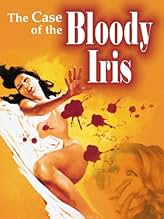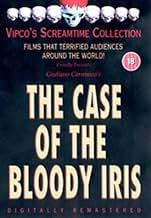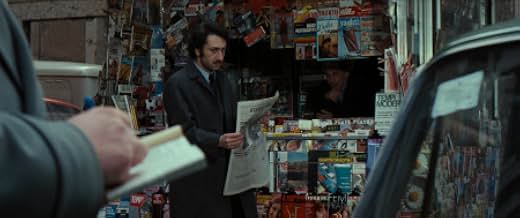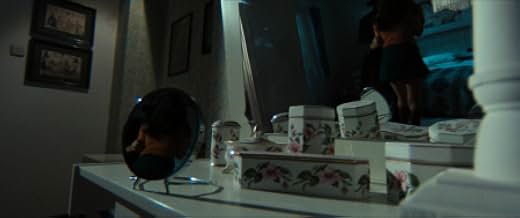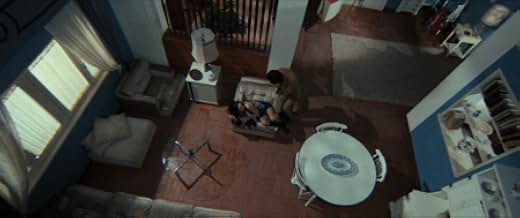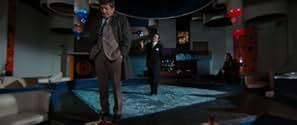As Lágrimas de Jennifer
Tendo escapado recentemente das garras de um culto sexual hippie, uma bela modelo é perseguida por um assassino em série cujas vítimas anteriores incluem ex-ocupantes de seu novo departament... Ler tudoTendo escapado recentemente das garras de um culto sexual hippie, uma bela modelo é perseguida por um assassino em série cujas vítimas anteriores incluem ex-ocupantes de seu novo departamento.Tendo escapado recentemente das garras de um culto sexual hippie, uma bela modelo é perseguida por um assassino em série cujas vítimas anteriores incluem ex-ocupantes de seu novo departamento.
- Adam - Jennifer's Ex-Husband
- (as Ben Carrá)
- Professor Isaacs - Sheila's Father
- (as George Rigaud)
- Nightclub Patron
- (não creditado)
- Nightclub Patron Versus Mizar
- (não creditado)
- Man in Elevator
- (não creditado)
- Nightclub Patron
- (não creditado)
- Nightclub Patron
- (não creditado)
- Iris Group Member
- (não creditado)
Avaliações em destaque
As in all gialli, a gloved killer wrapped in sharp black is mercilessly butchering physically beautiful young women for kicks, this time in a luxurious high rise apartment. Days after two women are murdered in a twenty-four hour period, models Jennifer (Edwige Fenech) and Marilyn (Paola Quattrini) move into one of the victims' apartment, hardly worried about the room's sordid past. "Life goes on," Marilyn scoffs, as if wishing to jinx herself into murder mystery oblivion. But it doesn't take long for the pair to realize that such things can hardly be laughed off, especially when considering the building itself seems to contain a number of shady characters easily able to commit such heinous acts. Suspects include a stereotyped lesbian neighbor, a misogynistic old woman that lives with her disturbingly deformed son, and even Jennifer's love interest (George Hilton), an architect with a crippling phobia of blood. And it doesn't help that Jennifer's maniacal ex-husband (Ben Carra) enjoys spending his days stalking his former wife instead of making a living.
In order to fully enjoy "The Case of the Bloody Iris", one must disregard the horrendous dubbing, the severely stiff performances, and the regularly asinine script — because this is a film about style and Edwige Fenech, not much else. (Those expecting the normal amount of generous giallo gore will be sorely disappointed.) The first murder is exquisitely shot — with hardly a word of dialogue to spare, it follows a comely blonde from a telephone booth to her apartment building's elevator, where she winds up slashed to death after the passengers depart one by one. Clearly inspiration for Angie Dickinson's gruesome offing in "Dressed to Kill" (which is miles better), the scene sets the tone of the film: absurd but competently suspenseful. Because much of the film is absurd — Jennifer's religious cult back-story is unneeded and contains a gratuitous orgy scene (hardly graphic) more laughable than tantalizing, and her bad habit of wandering away from safety in a time of danger is maddening — but, for the most part, "The Case of the Bloody Iris" classes it up while later '70s peers of the "Black Christmas" mindset didn't. It cares more about how it appears than how it builds intellectually, so thank God it looks like the chic second cousin of "Blowup" or some other mod infused character study.
Best of all is Edwige Fenech: never have I seen her in one of her famous gialli (those were directed by Sergio Martino, and I'm still in the process of trying to find a copy to view), and this film gives an idea as to why she is an underground legend. With her cat eyes, voluptuous figure, and jet black hair, it's impossible not to stare at her, mouth agape and all. One can hardly call her a fine actress, but Fenech has presence, a characteristic hardly found in other giallo women like Barbara Bouchet or Ida Galli. The camera clings to her composure almost passively; she can turn a poorly executed scene into a work of art by merely acting as its center. Maybe her films with Martino are better, but "The Case of the Bloody Iris" is a giallo minor but palatable.
The story revolves around a spate of vicious killings which happen in a posh high-rise block of apartments; gorgeous Edwige Fenech plays Jennifer, a model who has moved into the building and soon becomes a target for the deranged, rubber-glove wearing maniac.
Logic takes a backseat during the storytelling and there are moments which had me laughing in disbelief. In one scene, our hapless heroine wanders through a junkyard at night; for cheap 'shocks', car doors swing open, boots slam shut and a whole vehicle even topples off a stack no explanation for these spooky happenings is given.
Another moment has Jennifer attempting to enter a suspect's apartment. Finding it locked, she tries the keys on her own keyring, and hey, presto the last key opens the door!! What great security they have in this building.
As always, the killer's identity is only revealed in the final minutes, and the reason given for his violence stretches well beyond the realms of credibility.
Despite the flaws in the plot, the film moves along at a reasonable pace and when there is any danger of the momentum flagging, Carnimeo throws in some gratuitous T&A (and a lesbian) to keep us amused how very thoughtful of him! Nearly every actress gives us an eyeful before her untimely demise.
As giallos go, this is a consistently entertaining example and should definitely be seen by fans of the genre.
What I need and what you might like are films that are so abstract they have almost nothing to do with reality. They abstract from other movies in a kind of Xerox of Xerox way so that what you get has nothing to do with reality and all to do with film-making.
And no one is better at empty films, films with no emotional content or soul than Italians. Elsewhere I've noted that the Hollywood Italians attach to characters and violence as cinematic icons. Leone abstracted from the western and character fantasy.
Giallo is similar but does something a bit more clever to my mind. It has (for the time) extreme violence and sex (usually a few nipples) but not having much to do with each other. It takes these two abstractions and places it in a highly refined mystery-thriller context.
The way these things work is you have sexy women or thought so for the era, and since these are Italians, we are talking compliant bigbreasted teases. These are in some sex- related trades and get killed by some serial murderer. Many candidates are described, as if this were a real detective story that we could figure out. We can't of course; when the thing was abstracted all the elements of logic went, things like causality and clues.
In fact, it works in reverse. The things that seem logical turn out not to be. Illogic is always the way.
I like this giallo best of them all. It is the most stylish, the most cinematic (except for the murders which are mundane). By cinematic, I mean the way things are staged, the edges of walls are used. Mirrors.
And it has two characters that are extremely evocative. One is a carbon copy of Woody Allen, appearance, mannerisms and all. He is a photographer here in much the same stance that Allen himself appears as a filmmaker in many of his own movies. Logic says he is the killer.
Then we see a woman in the building where the main action takes place. You will swear that this is the same actor: Woody in disguise. All logic points to this Psycho-based notion.
There's a further structural/character fold. Another character about whom we learn has a bloody past is an architect. Now architects in movies are always special people, especially when they have the "plans" to what is important. Logic also says this is the guy and the story duly frames him.
Another movie reference: one potential killer is a member of a group sex, free love new age society. The bloody iris is not a sliced eyeball as you would expect. The iris is the symbol of this sexual commune and one appears bloody. _____
There's a scene in here that I value. You know how it is, that each genre has one scene that is so perfect it acts as a strange attractor for the whole genre? Here we have an inept European policeman who is investigating the crimes: young women in sexy jobs being killed. He and his boss are in an ornate office that one could only imagine of Italians.
The policeman is handed a letter, a piece of evidence and is asked his opinion. The cop goes on and on about how ordinary the stamp is, as if the entire value of the thing had nothing to do with the meaning of the letter, nor the document on which that meaning is recorded, nor even the container for that document, instead the designation on the container the stamp that indicates its genre only.
Watch this if you are blue.
Ted's Evaluation -- 3 of 3: Worth watching.
The Case of the Bloody Iris is part of Anchor Bay's four dvd set The Giallo Collection. Three of the movies can be purchased separately, but The Case of the Bloody Iris can only be purchased as part of the set.
The Case of the Bloody Iris starts out with a pretty young blonde woman being murdered in an elevator in an urban apartment building . The killer is wearing rubber gloves and stabs her with a knife that looks like a scalpel. A day later in the same apartment building, another woman is drowned in her bathtub by a killer wearing the same rubber gloves. This murder is pretty brutal to watch as far as movie murders go.
There is an architect by the name of Andrea (George Hilton), who dated the second murdered woman and starts seeing another woman, Jennifer (ably portrayed by the beautiful Edwige Fenech) who recently left a small religious group lead by a crazed guy who keeps harassing her and trying to get her back to the group. Through a flashback scene we discover that they were into group sex and and he seems to be, and is, seriously deranged. There is also a woman living with her father in an apartment in the building and she hits on every woman she encounters, which in this film are beautiful models and dancers.
A couple more murders into the film and Andrea is suspected by the police of performing the murders, especially after a woman is murdered on the street and witnesses see only him covered in blood and running away from the scene. The police have been following him using a detective who serves as a minor bit of comic relief (fortunately he doesn't try to be too funny). Jennifer also starts suspecting Andrea of committing the murders and after they arrange a secret meeting trying to elude the police, he seems more guilty then ever.
This is a well made movie with a decent script and is well acted by the entire cast. I recommend it for anyone who like a well made Giallo and also as a decent who dunnit.
This movie is released in a beautiful 2.35:1 widescreen display. The sound quality, while dated, sounded great out of my speakers. Extra features on the disk include an alternate stabbing scene and theatrical trailer. The alternate stabbing scene is just an abbreviated version of one of the stabbings late in the movie. Personally I liked the longer version in the film better. The Giallo Collection goes for around $40-50 which means each movie is around $10-13 each. This is a great price for movies that may have never seen the light of day in U.S. except for the Anchor Bay's decision to bring well made Italian Giallo's to the American market.
I do realize that it's far from perfect. It's got wooden performances, childish dialogue, illogical moments (more than a few), plot holes etc..., but it's entertaining as hell. These pure giallo's are guilty pleasures to be sure, featuring a number of knockout damsels in distress, gory murders, black gloved killers, a murder mystery with endless red herrings, law officials without an IQ and almost universally badly dubbed actors.
Here we have it all in abundance and it all works. The women here are quite simply stunning, the murder scenes inventive and well done, the appropriate amount of sleaze, impressive visuals and nice location scenery, a terrific musical score (catchy as hell), decent acting and a fair amount of shocks and suspense. It's also quite funny at times, I've never before or after seen a detective obsessing with stamps.
Highly recommended if you're a fan of giallo films.
Você sabia?
- CuriosidadesThis film belongs to the Italian film genre called "giallo", so named due to a series of popular Italian detective novels, published in 1929, all bound in yellow covers, "giallo" meaning "yellow" in Italian. Ultimately the term became generalized for all detective stories, in print or on film. While Mrs. Moss is waiting for the elevator, she drops a magazine called "Killer Man", with a cover design featuring the typical figure, immediately recognizable to giallo aficionados , of a shadowy silhouette, dressed in a fedora and raincoat, gloves, and, of course, carrying a knife. Though the covers are no longer yellow, little old lady Moss is a big fan of murder mysteries, "gialli" (plural) in Italian.
- Erros de gravaçãoGood thing they changed the film's English title to "Case of the Bloody Iris", since the Italian title translates as "Why the strange drops of blood on Jennifer's body?", but, though there are splatters of blood on most of the other women in the picture, and there are, indeed, drops of blood on an iris, apart from one little pin pricked finger, there are NO drops of blood, strange or otherwise, on Jennifer's body.
- Citações
Commissioner Enci: [to Sheila, of a letter she says she sent Jennifer as a joke] Say, how 'bout joking with a man? You might make out even better. You know, it's a shame to,see a girl like you wasting her talents. Try the opposite sex. That's what we're here for.
- ConexõesReferenced in Vestida para Matar (1980)
Principais escolhas
- How long is The Case of the Bloody Iris?Fornecido pela Alexa
Detalhes
- Data de lançamento
- País de origem
- Idioma
- Também conhecido como
- The Case of the Bloody Iris
- Locações de filme
- Gênova, Ligúria, Itália(location)
- Empresas de produção
- Consulte mais créditos da empresa na IMDbPro
- Tempo de duração1 hora 35 minutos
- Proporção
- 2.35 : 1
Contribua para esta página



